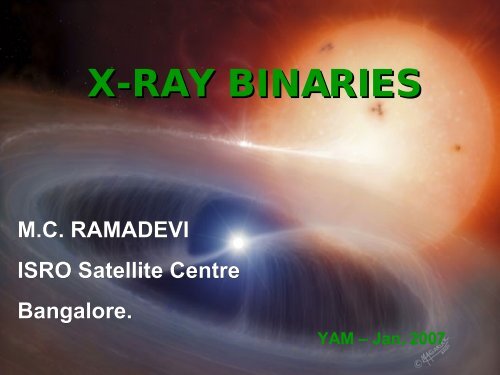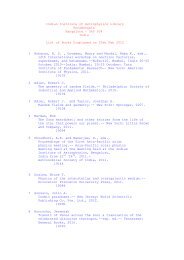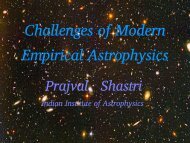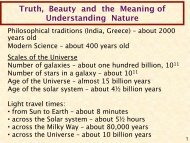You also want an ePaper? Increase the reach of your titles
YUMPU automatically turns print PDFs into web optimized ePapers that Google loves.
X-RAY BINARIES<br />
M.C. RAMADEVI<br />
ISRO Satellite Centre<br />
Bangalore.<br />
YAM – Jan, 2007
Discovery of X-<strong>ray</strong> <strong>Binaries</strong><br />
Historic discovery of a bright X<strong>ray</strong> source Sco X1 in 1962<br />
by Riccardo Giacconi and team; first extra-solar X-<strong>ray</strong> detection<br />
Detected during a rocket flight which was lauched to look for<br />
X<strong>ray</strong>s from Moon<br />
The source was extremely bright in X<strong>ray</strong>s.<br />
<strong>An</strong> optical star of 13 th magnitude was found at this location<br />
Was Quite Intriguing...<br />
TRIGGERED<br />
X-RAY<br />
Giacconi et al., 1962<br />
Sco X-1<br />
ASTRONOMY<br />
X<strong>ray</strong> background
THIS IS A BINARY SYSTEM WITH NEUTRON STAR AND A<br />
COMPANION STAR (OPTICAL COUNTERPART): X-RAY BINARY<br />
Later in 1970, the first X-<strong>ray</strong> satellite, UHURU, discovered another<br />
X-<strong>ray</strong> source Cen X-3<br />
counts<br />
Found to have PULSATIONS in X-<strong>ray</strong>s; 4.84 sec<br />
Only a neutron star can produce such pulsations<br />
time<br />
Continuous monitoring showed slight variation in the pulse period<br />
These variations - recognised as due to DOPPLER SHIFT; the star is<br />
moving in an ORBIT.<br />
X-<strong>ray</strong>s found to disappear for 11 hours in every 2.09 days; ECLIPSES<br />
counts<br />
Ahhhh….. ECLIPSING BINARY SYSTEM !!!!<br />
time<br />
Here we go…
What are X-<strong>ray</strong> <strong>Binaries</strong>?<br />
Special class of binaries which emit predominantly in<br />
X-<strong>ray</strong>s<br />
The Most luminous galactic X-<strong>ray</strong> sources<br />
Lx ~ 10 36 to 10 38 ergs/s<br />
Consist of a compact object and a companion star<br />
orbiting about a common centre of mass.<br />
The compact object can be a white dwarf (cataclysmic<br />
variables), a neutron star or a black hole.<br />
Companion star can be a normal star or a white dwarf.
X-<strong>ray</strong> emission<br />
What could possibly give rise to such high X-<strong>ray</strong> luminosities ?<br />
GRAVITY<br />
Compact star accretes matter from the companion star<br />
The gravitational potential energy of the in-falling matter is<br />
converted to kinetic energy eventually giving rise to radiation<br />
Gravitational potential energy<br />
Kinetic energy<br />
Heat (T ~ 10 7 K)<br />
(accreted matter swirls in)<br />
(friction between layers)<br />
(viscous heating)<br />
Radiation (X-<strong>ray</strong>s, UV)
How are X-<strong>ray</strong> <strong>Binaries</strong><br />
formed?<br />
•Start off with Binary Stars:<br />
2 stars, gravitationally bound<br />
to each other in an orbit, about<br />
a common centre of mass
Two mechanisms of mass transfer in a<br />
binary system<br />
Accretion from stellar wind<br />
Accretion through<br />
Roche lobe outflow
Accretion from stellar wind<br />
Accretion through<br />
Roche lobe outflow
Classification of X-<strong>ray</strong> <strong>Binaries</strong><br />
High-Mass X-<strong>ray</strong> <strong>Binaries</strong> (HMXB)<br />
HMXB :<br />
•Mass of the companion star , very<br />
massive, >~ few solar masses.<br />
•Usually NS systems accreting<br />
mass from the wind of companion,<br />
a Be star.<br />
Low-Mass X-<strong>ray</strong> <strong>Binaries</strong> (LMXB)<br />
LMXB:<br />
•Mass of the companion star
•Hard State<br />
Observations from X-<strong>ray</strong> binaries<br />
X-<strong>ray</strong> binaries are observed as transient sources which<br />
suddenly brighten up in X-<strong>ray</strong>s by a factor of 100 to 1000<br />
Light Curve has different profiles<br />
•Pulsations<br />
•Type I bursts<br />
•Type II bursts<br />
•Eclipses<br />
•Persistent outbursts<br />
Spectra suggests different emission processes<br />
•Different spectral states<br />
•High/Soft State<br />
•Very High State
X-<strong>ray</strong> Pulsars - Pulsations<br />
THIS IS NOT OBSERVED IN BLACK HOLE SYSTEMS<br />
Accretion onto a<br />
magnetized Neutron<br />
Star<br />
Accretion powered<br />
Pulsars<br />
B ~ 10 12 G<br />
Cen X-3, observed by UHURU;<br />
4.8 sec (Giacconi et. al., 1971)
Accretion onto weakly magnetised NS or WD<br />
Thermonuclear explosion on the surface of a WD or NS<br />
X-<strong>ray</strong> bursts<br />
(Type I Bursts)<br />
X-<strong>ray</strong> bursts – H burning<br />
15 s<br />
(1735-444)<br />
X-<strong>ray</strong> Superbursts – He burning
Type I Bursts<br />
Observation of thermonuclear energy<br />
Unstable, explosive burning in bursts (release over short time)<br />
Burst energy<br />
thermonuclear<br />
(from the surface of<br />
NS or WD)<br />
Persistent flux<br />
gravitational energy<br />
(from the accretion disk)<br />
THIS IS NOT OBSERVED IN BLACK<br />
HOLES, since they don’t have a surface.
Type II Bursts<br />
•Transient outbursts<br />
•Likely to originate due to<br />
instabilities in the<br />
accretion disk<br />
•Observed in both NS and<br />
BH systems<br />
120 days
Accretion onto black holes<br />
There is no hard surface. How can we detect it?<br />
Will there be any radiation from the infalling<br />
matter??<br />
Yes, from the accretion disk around a BH
Black Hole X-Ray <strong>Binaries</strong><br />
Accretion disks around black holes<br />
Strong X-<strong>ray</strong> sources<br />
Rapidly, erratically variable (with flickering<br />
on time scales of less than a second)<br />
Sometimes: Quasi-periodic oscillations (QPOs)<br />
Sometimes: Radio-emitting jets
Variabilities observed in Black Holes
Understanding Accretion<br />
Evolution of the accretion disk<br />
Spectra suggests different emission processes<br />
.<br />
m<br />
disk<br />
corona<br />
disk<br />
corona<br />
corona<br />
X-<strong>ray</strong> Properties<br />
Radio Properties
Soft state
Hard state
Example<br />
<strong>An</strong> outburst observed in 4U 1543-47<br />
June-August 2002, 2-10 keV LC<br />
Spectral and<br />
temporal<br />
analysis is<br />
required<br />
to understand<br />
accretion
Spectral-<br />
Temporal<br />
States:<br />
HSS:<br />
VHS:<br />
LHS:<br />
(Remillard &<br />
McClintock, 2004;<br />
Park et al 2004)
Why study X-<strong>ray</strong> <strong>Binaries</strong>?<br />
To understand accretion:<br />
Accretion - known to power the most luminous objects in the<br />
Universe.<br />
Understanding accretion around the compact objects like the<br />
neutron star and the stellar mass black holes can help<br />
understand accretion around supermassive black holes which<br />
form the heart of Active Galactic Nuclei, Quasars etc.<br />
Accretion is everywhere: be it the formation of stars or planetary<br />
systems or galaxies.<br />
Also to understand behavior of matter very close to the event<br />
horizon of a black hole where General Theory of Relativity is<br />
applicable, Black Hole X-<strong>ray</strong> <strong>Binaries</strong> are good candidates.<br />
X-<strong>ray</strong> <strong>Binaries</strong> form good laboratories for<br />
these studies.
Evolved picture of a Low-Mass X-<strong>ray</strong> binary:<br />
accretion through Roche-lobe overflow
India’s first multi-wavelength<br />
ASTROnomy SATellite<br />
ASTROSAT<br />
INDIA’S FIRST DEDICATED SATELLITE FOR ASTRONOMY<br />
UV/Optical 130-6000 nm), Soft X-<strong>ray</strong>s (0.2 - 10 keV) , Hard X-<strong>ray</strong>s (10 – 150
Thank You
LMXB<br />
•For NS, there is emission from boundary layer where disk<br />
meets NS and surface of NS (for a less magnetized NS).<br />
•Optical emission arises from outer disk, companion star, and<br />
X-<strong>ray</strong>s reprocessed by disk or companion.<br />
•For BH, X-<strong>ray</strong> emission is from disk.
HMXB<br />
Be star<br />
Neutron star<br />
•Mostly the compact object is a neutron star, in eccentric orbit around the<br />
companion<br />
•X-<strong>ray</strong>s transients occur when the neutron star accretes matter from the wind<br />
of the companion star (Be star)<br />
•No prominent disks emission
Binary Orbit<br />
CM<br />
M2<br />
M1<br />
a<br />
Compact star mass = M 1<br />
M<br />
Normal star mass = M 2<br />
M<br />
Binary separation = a, mass ratio q = M 2<br />
/M 1<br />
+<br />
Kepler' s law :<br />
2<br />
4π<br />
a<br />
3<br />
=<br />
G(<br />
M<br />
1<br />
+<br />
M<br />
2<br />
) M<br />
Θ<br />
P<br />
2<br />
10<br />
1/3<br />
1<br />
a = 3.5×<br />
10 M (1 +<br />
q)<br />
1/3<br />
P<br />
2/3<br />
hr<br />
cm
Geometry<br />
Observed phenomenology depends on viewing angle.
Typical X-<strong>ray</strong> bursts:<br />
• 10 36 -10 38 erg/s<br />
• duration 10 s – 100s<br />
• recurrence: hours-days<br />
• regular or irregular<br />
Frequent and very bright<br />
phenomenon !<br />
(stars 10 33 -10 35 erg/s)
10 s<br />
Discovery<br />
First X-<strong>ray</strong> pulsar: Cen X-3 (Giacconi et al. 1971) with UHURU<br />
T~ 5s<br />
Today:<br />
~50<br />
First X-<strong>ray</strong> burst: 3U 1820-30 (Grindlay et al. 1976) with ANS<br />
Today:<br />
~40<br />
Total ~230 X-<strong>ray</strong> binaries known
X-Ray Pulsar Cen X-3<br />
Pulses are<br />
modulated<br />
at orbital<br />
period of<br />
2.09 days
Formation of Accretion disk<br />
around the compact object

















